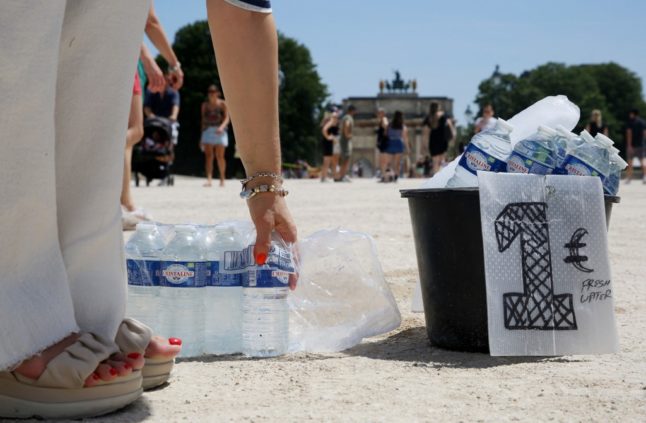Regional climate experts warn the Paris region is on track to see average temperatures rise by 3C in a century “if greenhouse gas emissions of human activities are not stopped.”
And the Groupe régional d’expertise sur le changement climatique (Grec) in the Paris region of Île-de-France is now saying that average temperatures in the region will continue to rise at an accelerating rate.
In the past 72 years, Île-de-France has seen its average temperature increase by 2C. By 2050, just 28 years from now, that figure could increase by an additional 1C – meaning average temperatures in the greater Paris region could increase by 3C in a century.
That roughly means that the number of “heatwave” days recorded in the Paris region – when temperatures are above normal for that time of year – will rise from 7 annually to between 28 to 30 days each year by 2070.
Part of the problem is something known as the urban heat sink effect – in which large towns and cities stay warmer at night because buildings and even roads release heat at night, when it is cooler.
As a result, night-time temperatures in towns and cities remain higher than in more rural areas. And every morning starts a little hotter than previous day, making cities more and more stifling. Night-time temperature in Paris can be up to 10C higher than in rural areas of – a difference recorded during the deadly 2003 heatwave.
The study also warned that the area would be subject to devastating widespread flooding.
Nationally, temperature records tumbled last month. In Biarritz, on the southwest coast of France, the highest temperature ever – 42.9C – was recorded on June 18th. On the same day, Tarbes, in the Hautes-Pyrénées, and Rochefort Saint-Aignan, Charente-Maritime, also recorded their highest-ever temperatures since records began, while more than 150 towns and cities set new temperature records for the month of June.
– Records mensuels :
🔻41.9°C à Cazaux (33, 40.2°C le 30/06/2015)
🔻40.5°C à Bordeaux (33, 39.2°C le 26/06/2011)
🔻40.3°C à Dax (40, 39.1°C le 21/06/2003)
🔻40.1°C à Angers (39.3°C le 29/06/2019)
🔻39.4°C à Pau (64, 38.1°C le 29/06/1950)
🔻39.3°C à Agen (47, 38.8°C le 29/06/1950)— Météo-France (@meteofrance) June 18, 2022
During the same heatwave, 35C was recorded at the Orly-Athis-Mons weather station – which the Grec group uses for its observations in Île-de-France.
Grec climatologists said that high temperatures will become increasingly common in the region. Board members Robert Vautard and Nathalie de Noblet said in a statement that the same station has recorded similar temperatures in June just twice previously in 75 years – in 1947 and 2017.
They said the trend is for such temperatures to be reached more often in the years to come: “It is to be expected that this type of event will become more and more usual if the greenhouse gas emissions of human activities are not stopped,” they said, adding that – without climate change – high temperature records in the region would be about 2C lower.
The Grec report mirrors national and international studies. Shortly after the country’s last heatwave ended the director of France’s Centre National de Recherches Météorologiques said: “This heatwave is exceptional in terms of its precocity. This type of event in mid-June is extremely rare.”
But, while they are exceptional today, scientists predict they will be the standard within just a few years. “Today, scientific knowledge on heatwaves is very clear. Any heatwave event is made more intense and severe by climate change … by the increase in temperature in the atmosphere resulting from greenhouse gas emissions.”
Only three years ago the highest temperature in France – 46C – was recorded in Verargues, Hérault, on June 28, 2019. The top 12 temperatures on record in France were set that day alone.
Records show that, of the 43 heatwaves France has endured between 1947 and 2020, nine occurred before 1989.
And a second heatwave this summer is already here. Forecasters are predicting temperatures could reach 40C in southeast France by Wednesday, July 6th, after temperatures got close to the mark on Sunday.
#Canicule : des températures à nouveau très chaudes cet après-midi dans le Sud-Est du pays.
🔴39.0°C à Apt (84)
🔴38.9°C à Lapalud (84)
🔴38.8°C aux Mayons (83)
🔴37.9°C à Castirla (2B)
🔴37.4°C à Montélimar (26)A noter 39.2°C à Cotignac (83) sur le réseau @infoclimat pic.twitter.com/vtAZwa6qOl
— Guillaume Séchet (@Meteovilles) July 3, 2022
For a heat wave alert to be officially triggered, certain temperatures must be reached both during the day and at night for three days in a row. The trigger thresholds vary according to the area – the south of the country needs to be warmer than the north.
With global warming continuing, heatwaves will become increasingly frequent, according to climatologist Françoise Vimeux: “During the second half of the 19th century a heat wave occurred once every 50 years. Now it happens every 10 years – it will get worse.
“We are heading towards warming levels of 1.5 degrees, and so the probability [of a heatwave] will be once every five years.”
Météo France’s climate predictions indicate that, by 2050, the deadly heatwave of 2003 would be considered part of “a normal summer, even slightly cool”.
That was the summer in which 15,000 excess deaths were recorded in France, including 5,000 in Paris, and attributed to the heat. It prompted the government of the day to set up the emergency response programme that can be implemented today.



 Please whitelist us to continue reading.
Please whitelist us to continue reading.
Member comments